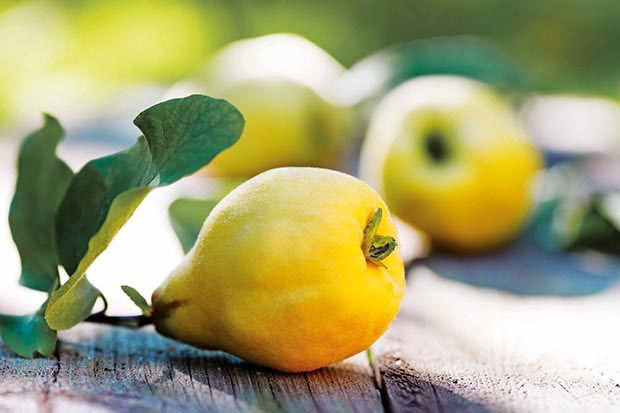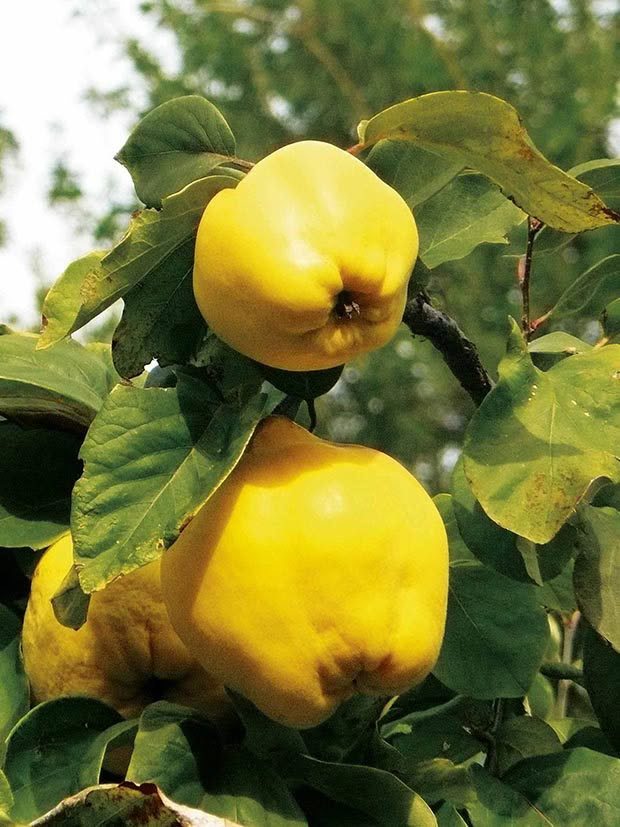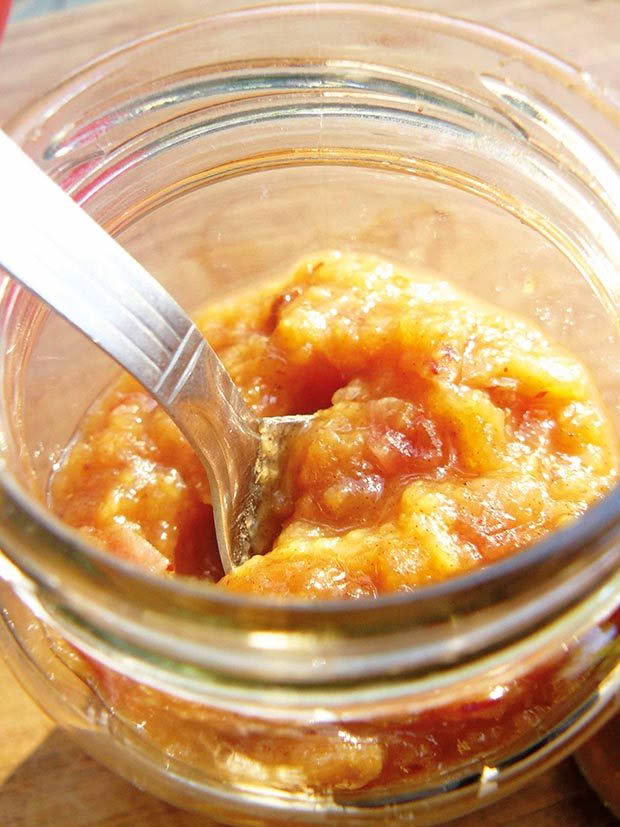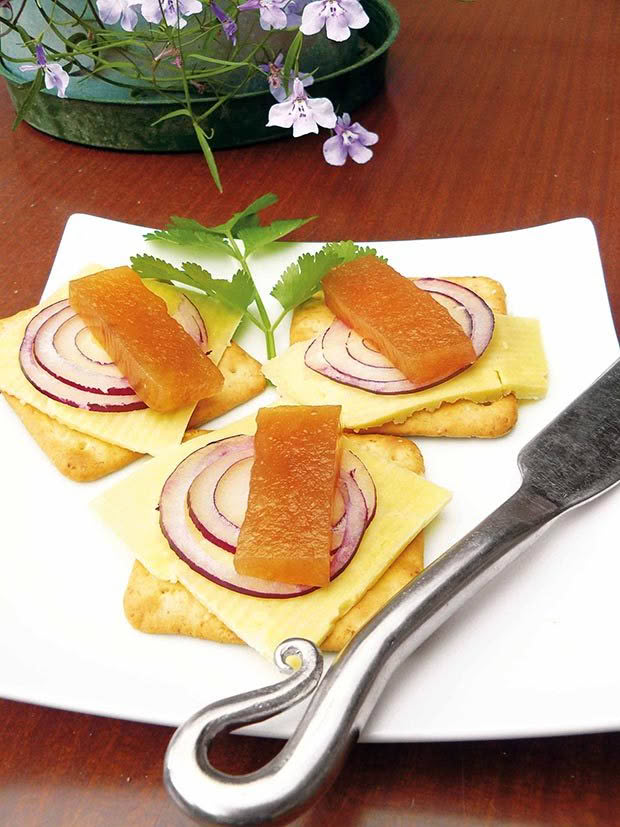How to cook with quince and two quince recipes: Quince paste and quince chutney

It’s completely inedible when raw and dangerous to cut up, with a heady, perfumed scent that is completely at odds with its appearance. Sound like your kind of fruit?
Words: Kristina Jensen
Once upon a time, in the good old days, everyone wanted to get their hands on some of these tough knobbly fruit. Quinces were a much sought-after delicacy, originating in Turkey, but you’ve always had to believe in a little bit of magic to truly discover their secret. Unfortunately the humble quince seems to have gone out of fashion, fallen from the tree as it were, to be usurped by its much tastier and versatile cousins, apples and pears.
But hang on a minute. Before you give up and turn the page to see what Murray Grimwood has to say this month about the state of the world, give quinces another chance. All it takes is a little heat and you will start to understand and appreciate why the Greeks regarded the quince as a symbol of fertility and dedicated it to the goddess, Aphrodite.
The exquisite fragrance of the fruit is the primary reason that it was celebrated in this way. Leave just one quince in a fruit bowl or on a windowsill, and it won’t be long before you notice a delicate fragrance of vanilla, citrus, and apple wafting into your kitchen. Fortunately when you cook quinces, they retain their delightful fragrance but the best is yet to come.

The real alchemy is all about colour; cook quinces and you’ll watch the yellowy-white flesh turn either a glorious deep rosy pink or a muted sunset orange. Doesn’t that make you just want to race out and find a tree and stew up a few?
I am lucky to have a generous friend who has a beautiful old quince tree. Every year, Steve faithfully contacts me to see if I want any, and I say yes please! He gets a jar or two of jam out of the deal so it works both ways.
Quinces are often to be found on ancient, gnarly-branched trees in a neglected or deserted orchard as they’re not popular in modern gardens. One tree that I routinely check every year is in a horse paddock way out in the middle of nowhere on the back road from Motueka to Nelson. The horses make a half-hearted attempt at eating the ones that fall on their side of the fence, and the bees and wasps help out, but on the roadside there are always plenty just going to waste until someone like me comes along and picks them up.
3 UPS AND DOWNS OF QUINCES
Quinces are very high in pectin which makes them perfect candidates for jams, jellies and membrillo. However, they do bruise very easily. I have also had what look like perfectly good quinces on the outside turn out to be all brown and rotten on the inside. If they start to show any signs of brown on the skin, use them quickly or you’ll lose them.
Quinces are very nice just stewed in water or white wine with a wee bit of sugar or honey thrown in. Add a dash of nutmeg and you’ve just created something divine as far as I am concerned.
3 FUN FACTS ABOUT QUINCES
1. Historically, marmalade was made from quinces. The English word ‘marmalade’ comes from the Portugese word marmelada which means ‘quince preparation’.
2. Shakespeare wrote that quince was the ‘stomach’s comforter’ and it turns out that medieval quince sweetmeats were once regarded as both an aid to digestion and a preventative against sickness.
3. According to the Greeks, pregnant women who eat lots of quinces will give birth to highly intelligent children.
Recipe: Quince Chutney

The variety of chillies that you use to make this chutney will determine both the heat and flavour. If you like yours hot, then seranos might be the chilli for you. I like flavour and heat so I like to use habeneros as they tend to impart a deliciously deep heat that is more of an aftertaste than an assault to the palate. Makes 5½ cups or so.
INGREDIENTS
3 large quinces
2 apples
2 onions
1 tbsp coarsely chopped ginger
2 chillies
3 cups white wine vinegar
1 ½ cups sugar
1 cinnamon stick
3 cloves
METHOD
Peel the quinces and the apples, chop into chunks and pop into a heavy-bottomed saucepan. Put the peeled onions and ginger in a food processor and blend, then add to the pan along with the vinegar. Simmer until the fruit is soft. Add remaining ingredients. Continue to simmer until the chutney is thick (approx 45-50 mins). Take out the cinnamon stick and cloves and spoon the mix into sterilised jars. Seal. Wait a few weeks before you tuck in to let the flavours mingle.
Recipe: Quince Paste (Quince Membrillo)

This is also called ‘fruit cheese’ or ‘quince cheese’, and is a very special way to preserve quinces. A Hungarian friend of mine told me once that it was her favourite thing ever because of its fragrant flavour, grainy texture, beautiful sunrise hue and the way it went perfectly with the goat cheeses that she used to make back in Hungary. In Spain, membrillo is typically paired with a cheese called manchego but I find it goes well with a good feta, blue vein cheese or a brie.
INGREDIENTS
2kg quinces
1 vanilla pod, split
caster sugar
2 strips of lemon peel (no pith)
METHOD
Wash, peel, core and chop the quinces, then place them into a large, heavy-bottomed pot along with the vanilla pod and add enough water to cover them. Bring to the boil and cook for 30-40 minutes until the quinces are very soft.
Drain the liquid off and weigh or measure the quince pulp, then return to the original pan along with an equal measure of sugar. Cook over a low heat, stirring until the sugar dissolves, and then continue to cook for 1-1½ hours, stirring every now and then, until the quince paste has thickened and is a deep orange colour.
Pour the paste into a sponge roll tin lined with baking paper and bake for a further hour at 150°C. Remove from the oven and cool. The paste should set nicely and can be cut it into manageable portions. Store in an airtight container in the fridge.
Love this story? Subscribe now!
 This article first appeared in NZ Lifestyle Block Magazine.
This article first appeared in NZ Lifestyle Block Magazine.
